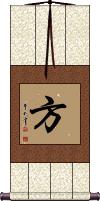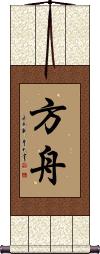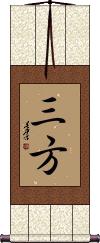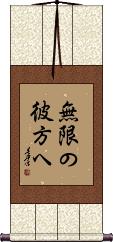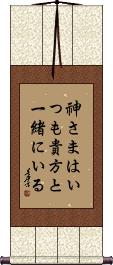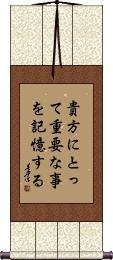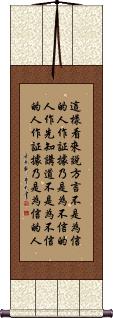Many custom options...
And formats...

方 in Chinese / Japanese...
Buy an 方 calligraphy wall scroll here!
Personalize your custom “方” project by clicking the button next to your favorite “方” title below...
1. Fang
2. Fong
3. Phuong
4. Ark
5. Fontaine
6. Jikata
7. Sanbo
8. Alfonso
9. Alfonzo
10. Alphonso
11. Fontenot
12. Lafond
13. Lafontaine
14. Lafountain
15. Wilfong
16. Alphonse
17. Asian Pride / Oriental Pride / AZN Pryde
18. I Need You
19. Shikataganai
Fang
方 is the most common version of a Chinese surname that romanizes as Fong from Taiwan or Fang from mainland China.
The meaning of this character is square, upright, honest, fair and square, direction, place, or side. Sometimes 方 can refer to a method, prescription, or way of doing things.
In Japanese, this can be the given names Michi, Masani, Masashi,Tamotsu, Tadashi. It can also be Japanese surnames Hon, Hou, Ho, Fuon, Pan, Ban, Tokukata, or Kata.
Fong
方 is the most common version of a Chinese surname that romanizes as Fong from Taiwan or Fang from mainland China.
The meaning of this character is square, upright, honest, fair and square, direction, place, or side. Sometimes 方 can refer to a method, prescription, or way of doing things.
In Japanese, this can be the given names Michi, Masani, Masashi,Tamotsu, Tadashi. It can also be Japanese surnames Hon, Hou, Ho, Fuon, Pan, Ban, Tokukata, or Kata.
Phuong
方 is the original Chinese character for the Vietnamese surname Phuong or Phương.
方 means square, upright, or side. In Vietnamese specifically, it can mean "direction" or "phoenix" (rebirth).
In Cambodian there is an unrelated surname, ភួង, meaning "garland necklace (of flowers)" which also romanizes as Phuong. This is probably not the character you want if your name is Cambodian (unless your ancestry is Chinese or you know what you are doing).
方舟 is the Chinese, Japanese, and old Korean name for an ark (as in Noah's Ark).
The literal translation is the square boat.
Fontaine
Jikata
Sanbo
Alfonso
Alfonzo
Alphonso
Fontenot
Lafond
Lafontaine
Lafountain
Wilfong
Alphonse
Asian Pride / Oriental Pride / AZN Pryde
東方自尊 is the universal way to write “Asian Pride.”
We worked on this one for a long time. The effort involved both Chinese and Japanese translators and lengthy discussions. If you have been searching for this term, there is a reason that it's hard to find the way to write “Asian Pride” in Chinese and Japanese - it's because of the inherent difficulties in figuring out a universal combination of characters that can be read in all languages that use forms of Chinese characters.
This final solution that you see to the left creates a reasonable title in Chinese and an exotic (perhaps unusual) title in Japanese (This could be read as “Eastern Self-Respect” in Japanese”).
Although not as natural, it does have the same meaning as Korean Hanja, and the older generation of Vietnamese people will be able to read it.
The first two characters literally mean “Oriental” and the second two mean “pride,” “self-esteem,” or “self-respect” (we chose the most non-arrogant way to say “pride”). If you have “Asian Pride” (sometimes spelled Asian Pryde) these are the characters for you.
Note: For those who wonder, there is nothing technically wrong with the word “Oriental.” It is a correct word, and any bad meanings were created by so-called “Asian Americans” and Caucasians in the United States. To say “Asian” would not completely correct the intended meaning since that would include people from Saudi Arabia, Iraq, Iran, India, and portions of Russia.
For further proof, if you were of East Asian ancestry and born in England, you would be known as a “British Oriental” (The “Oriental stigma” is basically an American creation and, therefore, applies mainly to the American English language - where they get a bit overzealous with political correctness).
Further, since the Chinese and Japanese word for Oriental is not English, they can not be construed as having ill meaning. On one trip to China or Japan, you will find many things titled with these two characters, such as malls, buildings, and business names. These places also use “Oriental” as their English title (much as we do since our Chinese business name starts with these same two characters).
In short, the first two characters have the meaning that Americans attach to “Asian” but is more technically correct.
I Need You
Some people like to say, “I love you” but others might want to say “I need you.” 貴方が必要 is “I need you” in Japanese.
The first two characters mean “You.”
The middle character is a connecting particle. In this case, it more or less means “are.”
The last two characters mean necessary, needed, essential, indispensable, or necessity.
The “I” in the title is implied. Effectively this means “I need you.”
Shikataganai
仕方が無い is Shikataganai, a Japanese phrase meaning “it cannot be helped,” or “nothing can be done about it.”
Other translations include: “It can't be helped,” “it's inevitable,” or “it's no use.”
This phrase is sometimes used in Japan to refer to when (Japanese) people as a whole must endure things that are beyond their control.
Note: Because this selection contains some special Japanese Hiragana characters, it should be written by a Japanese calligrapher.
To Infinity and Beyond
無限の彼方へ means “to infinity and beyond,” in Japanese.
This is how the slogan/phrase from Toy Story's Buzz Lightyear was translated from the movie into Japanese.
Note: Because this selection contains some special Japanese Hiragana characters, it should be written by a Japanese calligrapher.
God is Always With You
Remember What Is Important To You
1 Corinthians 14:22
Here is 1 Corinthians 14:22 in Chinese.
The text with punctuation:
这样看来,说方言,不是为信的人作证据,乃是为不信的人。作先知讲道,不是为不信的人作证据,乃是为信的人。
Hand-painted calligraphy does not retain punctuation.
This translation is from the Chinese Union Bible.
You may know it from the KJV as:
Wherefore tongues are for a sign, not to them that believe, but to them that believe not: but prophesying serveth not for them that believe not, but for them which believe.
Return to Dwell in Gardens and Fields Poem
This is Tao Yuanming's poem, “Returning to Dwell in Gardens and Fields.”
少無適俗韻 性本愛丘山。
誤落塵網中 一去三十年。
羈鳥戀舊林 池魚思故淵。
開荒南野際 抱拙歸園田。
方宅十餘畝 草屋八九間。
榆柳蔭後簷 桃李羅堂前。
暖暖遠人村 依依墟裡煙。
狗吠深巷中 雞鳴桑樹顛。
戶庭無塵雜 虛室有餘閒。
久在樊籠裡 復得返自然。
Not the results for 方 that you were looking for?
Below are some entries from our dictionary that may match your 方 search...
| Characters If shown, 2nd row is Simp. Chinese |
Pronunciation Romanization |
Simple Dictionary Definition |
方 see styles |
fāng fang1 fang michi みち |
More info & calligraphy: Fang(1) direction; way; side; area (in a particular direction); (2) (often 私の方, あなたの方, etc.) side (of an argument, etc.); one's part; (3) type; category; (4) field (of study, etc.); (5) indicates one side of a comparison; (6) way; method; manner; means; (7) length (of each side of a square); (given name) Michi Square; place; correct; a means, plan, prescription; then, now, just. |
三方 see styles |
mitsukata みつかた |
More info & calligraphy: Sanbo |
地方 see styles |
dì fang di4 fang5 ti fang chikata ちかた |
More info & calligraphy: Jikata(1) district; region; area; locality; (2) (See 中央・2) the country; countryside; the provinces; rural area; (3) (obsolete) (Imperial Japanese Army jargon) civilian society; (surname) Chikata |
方舟 see styles |
fāng zhōu fang1 zhou1 fang chou houshuu / hoshu ほうしゅう |
More info & calligraphy: Arkark (i.e. Noah's); (given name) Houshuu |
日方 see styles |
rì fāng ri4 fang1 jih fang hinata ひなた |
the Japanese side or party (in negotiations etc) (personal name) Hinata |
仕方が無い see styles |
shikataganai しかたがない |
More info & calligraphy: Shikataganai |
お方 see styles |
okata おかた |
this lady or gentleman |
一方 see styles |
yī fāng yi1 fang1 i fang hitokata ひとかた |
a party (in a contract or legal case); one side; area; region (1) (honorific or respectful language) one person; (adjectival noun) (2) (often in negative form) ordinary; common; (personal name) Kazutaka one side |
七方 see styles |
qī fāng qi1 fang1 ch`i fang chi fang |
(Chinese medicine) the seven kinds of prescriptions 大方[da4 fang1], 小方[xiao3 fang1], 緩方|缓方[huan3 fang1], 急方[ji2 fang1], 奇方[ji1 fang1], 偶方[ou3 fang1] and 重方[chong2 fang1] or 複方|复方[fu4 fang1] |
万方 see styles |
mankata まんかた |
many lands; many means; (surname) Mankata |
上方 see styles |
shàng fāng shang4 fang1 shang fang kamigata かみがた |
place above (it); upper part (of it) (noun - becomes adjective with の) (See 下方) upper part; upper region; region above; (place-name, surname) Kamigata 上手 An abbot 上方 originally meant a mountain monastery. |
下方 see styles |
xià fāng xia4 fang1 hsia fang kahou / kaho かほう |
underneath; below; the underside; world of mortals; to descend to the world of mortals (of gods) (noun - becomes adjective with の) (See 上方・じょうほう) lower region; lower part; region below; (place-name) Shimogata |
両方 see styles |
ryoukata / ryokata りょうかた |
(noun - becomes adjective with の) (See 片方・1) both; both sides; both parties; (surname) Ryōkata |
中方 see styles |
zhōng fāng zhong1 fang1 chung fang nakahou / nakaho なかほう |
the Chinese side (in an international venture) (place-name) Nakahou |
丹方 see styles |
dān fāng dan1 fang1 tan fang |
folk remedy |
乃方 see styles |
daihou / daiho だいほう |
(given name) Daihou |
久方 see styles |
hisakata ひさかた |
(archaism) sky; moon; (p,s,g) Hisakata |
乘方 see styles |
chéng fāng cheng2 fang1 ch`eng fang cheng fang |
(math.) to exponentiate; to raise (a number) to a power; exponentiation; power |
乙方 see styles |
yǐ fāng yi3 fang1 i fang otsukata おつかた |
party B (in a contract) (cf. 甲方[jia3 fang1], party A) (place-name) Otsukata |
二方 see styles |
futakata ふたかた |
(1) (honorific or respectful language) both people; two people; (2) two directions; both directions; (place-name, surname) Futakata |
五方 see styles |
wǔ fāng wu3 fang1 wu fang gohou / goho ごほう |
the five regions: the east, south, west, north and center; all parts; China and the lands beyond its frontiers five directions (center, north, south, east, and west) |
井方 see styles |
igata いがた |
(surname) Igata |
京方 see styles |
kyougata / kyogata きょうがた |
the direction of Kyoto; Kansai area; citizens of Kyoto; nobles |
仁方 see styles |
nigata にがた |
(place-name) Nigata |
今方 see styles |
imagata いまがた |
(adv,n) a moment ago; (surname) Imakata |
仕方 see styles |
shikata しかた |
way; method; means; resource; course |
他方 see styles |
tā fāng ta1 fang1 t`a fang ta fang tahou / taho たほう |
(noun - becomes adjective with の) (1) one (esp. of two); the other; one way; the other way; one direction; the other direction; one side; the other side; one party; the other party; (conjunction) (2) (See 一方・いっぽう・2) on the other hand other lands |
付方 see styles |
fù fāng fu4 fang1 fu fang tsukekata つけかた |
credit side (of a balance sheet), as opposed to 收方[shou1 fang1] (1) way of affixing something; (2) way of recording something (to a logbook, etc.) |
仙方 see styles |
xiān fāng xian1 fang1 hsien fang |
prescription of elixir; potion of immortality; potion prescribed by an immortal |
仲方 see styles |
nakagata なかがた |
(place-name) Nakagata |
Click here for more 方 results from our dictionary
The following table may be helpful for those studying Chinese or Japanese...
| Title | Characters | Romaji (Romanized Japanese) | Various forms of Romanized Chinese | |
| Fang | 方 | hou / ho | fāng / fang1 / fang | |
| Fong | 方 | hou / ho | fāng / fang1 / fang | |
| Phuong | 方 | fāng / fang1 / fang | ||
| Ark | 方舟 | hakobune | fāng zhōu fang1 zhou1 fang zhou fangzhou | fang chou fangchou |
| Fontaine | 方丹 | fāng dān / fang1 dan1 / fang dan / fangdan | fang tan / fangtan | |
| Jikata | 地方 | jikata | dì fāng / di4 fang1 / di fang / difang | ti fang / tifang |
| Sanbo | 三方 | sanbou / sanpou / mitsukata sanbo / sanpo / mitsukata | ||
| Alfonso | 阿方索 | ā fāng suǒ a1 fang1 suo3 a fang suo afangsuo | a fang so afangso |
|
| Alfonzo | 阿方索 | ā fāng suǒ a1 fang1 suo3 a fang suo afangsuo | a fang so afangso |
|
| Alphonso | 阿方索 | ā fāng suǒ a1 fang1 suo3 a fang suo afangsuo | a fang so afangso |
|
| Fontenot | 方特諾 方特诺 | fāng tè nuò fang1 te4 nuo4 fang te nuo fangtenuo | fang t`e no fangteno fang te no |
|
| Lafond | 拉方德 | lā fāng dé la1 fang1 de2 la fang de lafangde | la fang te lafangte |
|
| Lafontaine | 拉方丹 | lā fāng dān la1 fang1 dan1 la fang dan lafangdan | la fang tan lafangtan |
|
| Lafountain | 拉方丹 | lā fāng dān la1 fang1 dan1 la fang dan lafangdan | la fang tan lafangtan |
|
| Wilfong | 威爾方 威尔方 | wēi ěr fāng wei1 er3 fang1 wei er fang weierfang | wei erh fang weierhfang |
|
| Alphonse | 阿爾方斯 阿尔方斯 | ā ěr fāng sī a1 er3 fang1 si1 a er fang si aerfangsi | a erh fang ssu aerhfangssu |
|
| Asian Pride Oriental Pride AZN Pryde | 東方自尊 东方自尊 | tou hou zi son touhouzison to ho zi son | dōng fāng zì zūn dong1 fang1 zi4 zun1 dong fang zi zun dongfangzizun | tung fang tzu tsun tungfangtzutsun |
| I Need You | 貴方が必要 | ana ta ga hitsu you anatagahitsuyou ana ta ga hitsu yo | ||
| Shikataganai | 仕方が無い | shikataganai | ||
| To Infinity and Beyond | 無限の彼方へ | mugen no kanata e mugennokanatae | ||
| God is Always With You | 神さまはいつも貴方と一緒にいる | kamisama wa itsumo watashi to anata to issho ni iru kamisama wa itsumo watashi to anata to isho ni iru | ||
| Remember What Is Important To You | 貴方にとって重要な事を記憶する | anata ni totte jyuyou na koto wo kioku suru anata ni totte jyuyo na koto wo kioku suru | ||
| 1 Corinthians 14:22 | 這樣看來說方言不是為信的人作証據乃是為不信的人作先知講道不是為不信的人作証據乃是為信的人 这样看来说方言不是为信的人作证据乃是为不信的人作先知讲道不是为不信的人作证据乃是为信的人 | zhè yàng kàn lái shuō fāng yán bù shì wéi xìn de rén zuò zhèng jù nǎi shì wéi bù xìn de rén zuò xiān zhī jiǎng dào bù shì wéi bù xìn de rén zuò zhèng jù nǎi shì wéi xìn de rén zhe4 yang4 kan4 lai2 shuo1 fang1 yan2 bu4 shi4 wei2 xin4 de ren2 zuo4 zheng4 ju4 nai3 shi4 wei2 bu4 xin4 de ren2 zuo4 xian1 zhi1 jiang3 dao4 bu4 shi4 wei2 bu4 xin4 de ren2 zuo4 zheng4 ju4 nai3 shi4 wei2 xin4 de ren2 zhe yang kan lai shuo fang yan bu shi wei xin de ren zuo zheng ju nai shi wei bu xin de ren zuo xian zhi jiang dao bu shi wei bu xin de ren zuo zheng ju nai shi wei xin de ren | che yang k`an lai shuo fang yen pu shih wei hsin te jen tso cheng chü nai shih wei pu hsin te jen tso hsien chih chiang tao pu shih wei pu hsin te jen tso cheng chü nai shih wei hsin te jen che yang kan lai shuo fang yen pu shih wei hsin te jen tso cheng chü nai shih wei pu hsin te jen tso hsien chih chiang tao pu shih wei pu hsin te jen tso cheng chü nai shih wei hsin te jen |
|
| Return to Dwell in Gardens and Fields Poem | 少無適俗韻性本愛丘山誤落塵網中一去三十年羈鳥戀舊林池魚思故淵開荒南野際抱拙歸園田方宅十余畝草屋八九間榆柳蔭后檐桃李羅堂前暖暖遠人村依依墟里煙狗吠深巷中雞鳴桑樹顛戶庭無塵雜虛室有余閑久在樊籠里復得返自然 少无适俗韵性本爱丘山误落尘网中一去三十年羁鸟恋旧林池鱼思故渊开荒南野际抱拙归园田方宅十余亩草屋八九间榆柳荫后檐桃李罗堂前暖暖远人村依依墟里烟狗吠深巷中鸡鸣桑树颠户庭无尘杂虚室有余闲久在樊笼里复得返自然 | shào wú shì sú yùn xìng běn ài qiū shān wù luò chén wǎng zhōng yī qù sān shí nián jī niǎo liàn jiù lín chí yú sī gù yuān kāi huāng nán yě jì bào zhuō guī yuán tián fāng zhái shí yú mǔ cǎo wū bā jiǔ jiān yú liǔ yīn hòu yán táo lǐ luó táng qián nuǎn nuǎn yuǎn rén cūn yī yī xū lǐ yān gǒu fèi shēn xiàng zhōng jī míng sāng shù diān hù tíng wú chén zá xū shì yǒu yú xián jiǔ zài fán lóng lǐ fù dé fǎn zì rán shao4 wu2 shi4 su2 yun4 xing4 ben3 ai4 qiu1 shan1 wu4 luo4 chen2 wang3 zhong1 yi1 qu4 san1 shi2 nian2 ji1 niao3 lian4 jiu4 lin2 chi2 yu2 si1 gu4 yuan1 kai1 huang1 nan2 ye3 ji4 bao4 zhuo1 gui1 yuan2 tian2 fang1 zhai2 shi2 yu2 mu3 cao3 wu1 ba1 jiu3 jian1 yu2 liu3 yin1 hou4 yan2 tao2 li3 luo2 tang2 qian2 nuan3 nuan3 yuan3 ren2 cun1 yi1 yi1 xu1 li3 yan1 gou3 fei4 shen1 xiang4 zhong1 ji1 ming2 sang1 shu4 dian1 hu4 ting2 wu2 chen2 za2 xu1 shi4 you3 yu2 xian2 jiu3 zai4 fan2 long2 li3 fu4 de2 fan3 zi4 ran2 shao wu shi su yun xing ben ai qiu shan wu luo chen wang zhong yi qu san shi nian ji niao lian jiu lin chi yu si gu yuan kai huang nan ye ji bao zhuo gui yuan tian fang zhai shi yu mu cao wu ba jiu jian yu liu yin hou yan tao li luo tang qian nuan nuan yuan ren cun yi yi xu li yan gou fei shen xiang zhong ji ming sang shu dian hu ting wu chen za xu shi you yu xian jiu zai fan long li fu de fan zi ran | shao wu shih su yün hsing pen ai ch`iu shan wu lo ch`en wang chung i ch`ü san shih nien chi niao lien chiu lin ch`ih yü ssu ku yüan k`ai huang nan yeh chi pao cho kuei yüan t`ien fang chai shih yü mu ts`ao wu pa chiu chien yü liu yin hou yen t`ao li lo t`ang ch`ien nuan nuan yüan jen ts`un i i hsü li yen kou fei shen hsiang chung chi ming sang shu tien hu t`ing wu ch`en tsa hsü shih yu yü hsien chiu tsai fan lung li fu te fan tzu jan shao wu shih su yün hsing pen ai chiu shan wu lo chen wang chung i chü san shih nien chi niao lien chiu lin chih yü ssu ku yüan kai huang nan yeh chi pao cho kuei yüan tien fang chai shih yü mu tsao wu pa chiu chien yü liu yin hou yen tao li lo tang chien nuan nuan yüan jen tsun i i hsü li yen kou fei shen hsiang chung chi ming sang shu tien hu ting wu chen tsa hsü shih yu yü hsien chiu tsai fan lung li fu te fan tzu jan |
|
| In some entries above you will see that characters have different versions above and below a line. In these cases, the characters above the line are Traditional Chinese, while the ones below are Simplified Chinese. | ||||
Successful Chinese Character and Japanese Kanji calligraphy searches within the last few hours...
